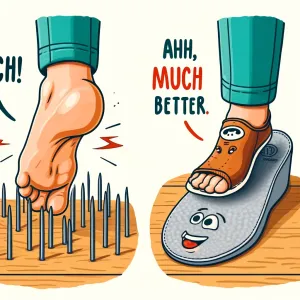Managing and Understanding Plantar Fasciitis Flare-Ups

Understanding Plantar Fasciitis Flare-Ups #
Experiencing recurring foot and heel pain might indicate a flare-up of plantar fasciitis, the most common culprit behind such discomfort. This condition arises when the plantar fascia, the connective tissue running along your foot's underside, becomes inflamed due to excessive strain.
To combat this, utilizing clinically proven Steply insoles for plantar fasciitis can alleviate pain and prevent further occurrences.
What Triggers Plantar Fasciitis? #
Several factors can exacerbate the stress on your feet, leading to plantar fasciitis flare-ups. Symptoms often include abrupt pain in your heel or arch, intensifying throughout the day, especially noticeable in the morning.
Common Causes of Flare-Ups: #
Increased Physical Activity: A sudden boost in activity levels, like starting a new exercise regimen or jobs that require prolonged standing, can aggravate symptoms. It's crucial to gradually intensify activities to sidestep injuries such as plantar fasciitis. Implement foot stretches before and after activities and consider shoes with arch-supporting inserts like Steply insoles.
Rapid Weight Gain: Sudden weight increases, including those due to pregnancy, add extra pressure on your feet and plantar fascia, leading to inflammation and pain. Rest and foot elevation can help, and discussing weight management with your healthcare provider may be advisable.
Inappropriate Footwear: Shoes lacking proper support, such as flip-flops, high heels, or worn-out sneakers, can induce heel and arch pain. Proper footwear is essential in preventing recurrent plantar fasciitis. Opt for comfortable, well-fitting shoes and consider swapping your insoles with ones specially designed for plantar fasciitis.
Neglecting Exercises: Discontinuing exercises meant for plantar fasciitis, like calf stretches and toe curls, might cause the condition to return. These exercises strengthen the plantar fascia and prevent tears.
Other Risk Factors: Certain people are more susceptible to plantar fasciitis flare-ups due to factors such as flat feet, high arches, overweight, specific ailments like bunions or arthritis, and certain occupational or recreational activities that involve extensive standing or running.
Duration of Plantar Fasciitis Flare-Ups #
While the recurrence of plantar fasciitis can be frustrating, the majority of sufferers find relief through simple measures like rest, stretching, and using specific insoles, with about 90% recovering within 10 months.
Treatment Options #
Implementing minor adjustments in your daily routine can significantly enhance your comfort and prevent future flare-ups. Here are some effective treatments you can administer at home:
- Insoles: Use Steply insoles designed for plantar fasciitis, which are clinically proven to mitigate and prevent pain.
- Stretching: Daily stretching of the lower legs and feet for at least 20 minutes can maintain strength and flexibility in the plantar fascia.
- Massaging: Employ a massage ball, golf ball, or a frozen water bottle to massage the heel and arch area, reducing stiffness and alleviating pain.
- Rest and Ice: Limit activities when experiencing pain and apply ice to reduce inflammation.
- Pain Relief: Consider NSAIDs like ibuprofen for pain relief, or opt for natural alternatives such as topical treatments.
- Night Splints: Using night splints can expedite recovery by alleviating morning pain. Steply offers comfortable alternatives like the UltraStretch® Night Sock.
If symptoms persist despite these measures, consulting a podiatrist for a specialized treatment plan might be necessary. In severe cases, options like physical therapy or corticosteroid injections are considered, though surgery is rarely required.
Does Plantar Fasciitis Ever Fully Resolve? #
Plantar fasciitis can resolve on its own with adequate rest, regular stretching, and preventative measures such as wearing properly supportive shoes and orthotic insoles. Steply insoles for plantar fasciitis are crafted by podiatrists to offer optimal arch support, premium cushioning, and a deep heel cup, ensuring a comfortable and supportive fit to prevent the recurrence of plantar fasciitis.